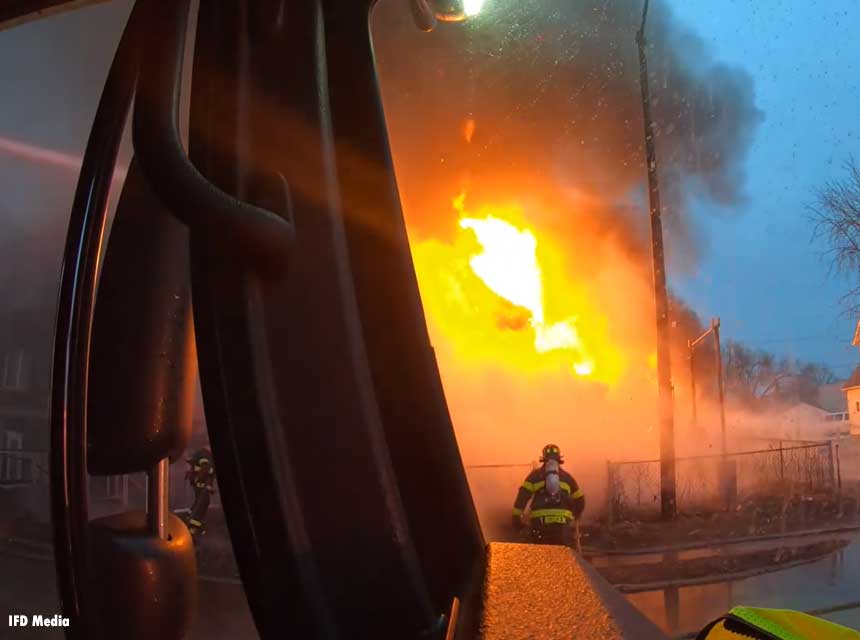Article and photos by Paul Shapiro
When using water for the extinguishing agent in fire suppression, the goal is to match the fire volume (British thermal units) with enough water to put it out. This is not a new concept. Firefighters have done this for decades.
There is a rule of thumb in firefighting that states when attacking a fire with the stream of choice, a knockdown, or at least a significant progress toward a knockdown, should be achieved within 30 seconds. If after 30 seconds, the stream of choice is failing, you need to apply more water volume. This rule of thumb should be the basis behind an offensive fire attack.
The Blitz Attack (BA)
The bottom line is, the faster you put the fire out, the better off you will be. This is where the Blitz Attack (BA) concept of firefighting comes into play. The BA is an offensive fire attack strategy which involves attacking a fire with as large a volume of water as safely and efficiently as possible to knock down the fire in seconds. Yes, I did say seconds.
The BA is a very simple concept: Blast a fire with as much water as possible to achieve a knockdown as quickly as possible.
Where can you use the BA? It can be used on fires ranging in size from a dumpster, vehicle, or a house fire to a fully involved garage or commercial structure fire. Again, attack the fire with as much water as possible, trying for a knockdown within 30 seconds. If after 30 seconds the fire is just laughing at you and saying, “Is that all you’ve got, baby?” apply a larger volume of water.
Deploying the BA
By what means should the BA be deployed? A simple rule of thumb follows: Make it as easy as possible. For me, the easiest method is a fixed master stream (deck gun or wagon battery). Simply aim the gun at the fire, and let it go. There is no discharge line to stretch and no nozzle to hang onto. For obvious reasons, this will not always work. The limiting factor is engine placement in relation to the battlefield. If the fire is 300 feet from the street and around the corner, then the deck gun will not work. So now what? A portable monitor can surely move the big water at far distances from the engine; however, is this an easy evolution to perform? Most portable monitors weigh 30 to 40 pounds. Manufacturers require that they be secured to a fixed object before use. A portable monitor has limitations in its stream direction because the barrel of the gun cannot be lowered past a certain point in the portable mode. Many offensive fire attacks necessitate that the stream direction be lower than a portable master stream device can achieve. Finally, setup time could be long. Am I saying that the portable monitor is not an option? Absolutely not! If it works for you, use it.
How about a preconnected monitor supplied by a single 2½-inch line? Flows up to 500 gallons per minute can be obtained up to 200 feet.

Now, let’s take it one step further. What do you think of a flow of 500 gpm delivered from a handline deployed with as little as two firefighters? Yes, a handheld line. Why? Because it’s lighter and faster to deploy and, besides that, because we can. With special hose-handling techniques, a high-flow handline with the above-mentioned statistics is a realistic choice when using the BA. It involves the two firefighters stretching the line and sitting on it at the point where the attack will take place. By keeping as much hose as possible on the ground (all but the last two feet before the nozzle) and the weight of the firefighters on the hose, most of the nozzle reaction is absorbed into the ground, thus making it possible to use a high-flow handline. The following is a list of hose sizes with their equivalent flows that are possible in the high-flow handline concept.
1¾-inch standard 250 gpm
1.88-inch 350 gpm
2-inch standard 400 gpm
2½-inch and 3-inchstandard 500 gpm
If a tank water operation is to be initiated with a large flow, remember that the factor that dictates the maximum flow that can be delivered is the water flow capability of tank-to-pump plumbing. The standard-issue plumbing design allows for about 500 gpm. If more water is attempting to discharge from the pump than the tank-to-pump plumbing will allow, cavitation will occur. Know your pumpers’ capabilities.
The BA gives a new meaning to initial fire attack. Instead of thinking gpm for extinguishment, the concept of gallons per second now comes into play. Hit Big Red with everything you can to stop him dead in his tracks.
Paul Shapiro is Director of Fire Flow Technology. He is a nationally recognized instructor on large flow water delivery. He is also a retired engineer from the City of Las Vegas (NV) Fire Department. Paul has authored numerous articles for fire trade magazines. He has been in the fire service since 1981 and is author of the popular book Layin’ the Big Lines and produced the first in a series of videos on large flow water delivery. Paul can be reached at 702-293-5150 or Layinline @aol.com to answer any questions.


